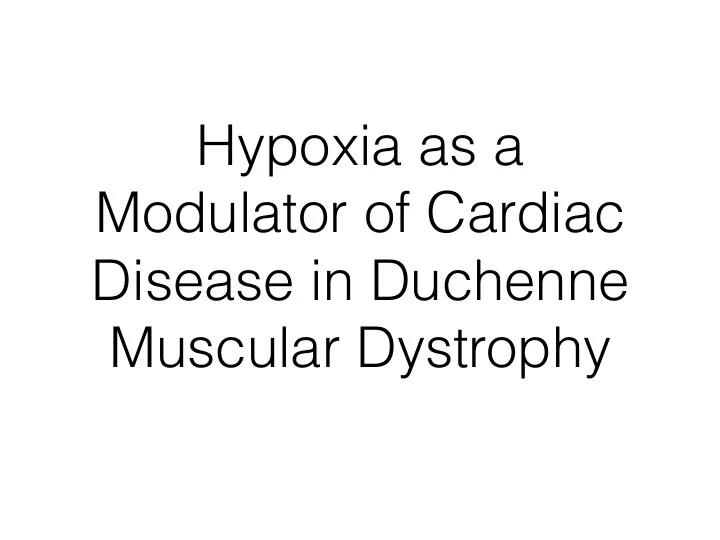

Hypoxia as a Modulator of Cardiac Disease in Duchenne Muscular Dystrophy
Natural History of DMD Skeletal Muscle Weakness Wheelchair Bound Subclinical Ventilatory Hypoxia? Support Cardiac Best to Dysfunction Prevent Time Damage is Done
Preventing Cardiac Injury • Things that we know • Disruption of Various damage dystrophic Pathways (mice) hearts • Utrophin • Integrin Expression • Time • Altered glycosylation • Increases in work patterns (Cmah) load • Calcium Handling Proteins • Increased Heart • Mitochondrial targeted Rate proteins • Increased Blood • Regulators of fibrosis • Hypoxia Pressure
Hypoxia in Dystrophic Mice • With acute hypoxia- mdx mice develop a significant acidosis. • Likely caused by increased lactate production
Metabolic Inefficiency of the Dystrophic Heart • Dystrophic hearts need more oxygen to do the same amount of work as healthy hearts. • Dystrophic hearts are not able to fully use the oxygen available.
Hypoxia in the Dystrophic Heart • 3 weeks of hypoxia is sufficient to cause significant damage in young mdx mice.
Normal Breathing
Dystrophic Breathing
Hypoxia is Very Common in Duchenne Muscular Dystrophy Patients • Standard practice is that patients generally have evidence of sleep disruption prior to initiation of ventilatory support. • Hypoxia creates periods of increased cardiac activity, increased heart rate and strength of contraction. • Hypoxia is sufficient to damage the dystrophic mouse heart.
Safe and Effective Methods Exist to Treat Hypoxia • In stark contrast to most novel pathways that exacerbate dystrophic cardiomyopathies. Hypoxia can be prevented by clinically accepted methods. • No FDA approval necessary
Dystrophic Breathing with Extra Oxygen
Current Proposal • Examine how supplemental oxygen improves cardiac function and structure with challenge. • Assess the effect of supplemental oxygen on skeletal muscle function, both limb and diaphragm. • Oxygen will be increased by both increasing the fraction of oxygen inhaled and the pressure of the air.
Acknowledgments
Recommend
More recommend